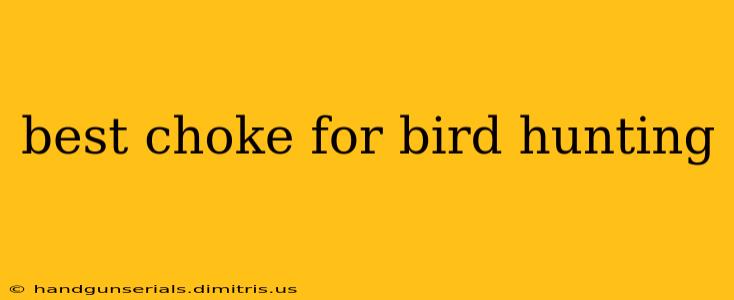Choosing the right choke tube for your shotgun is crucial for successful bird hunting. The choke affects the shot pattern, determining how tightly the pellets group together after leaving the barrel. Selecting the wrong choke can mean the difference between a clean kill and a missed shot, especially when targeting smaller, faster birds. This guide will help you navigate the world of choke tubes and find the best one for your bird hunting needs.
Understanding Choke Tubes and Their Impact on Shot Patterns
Choke tubes are cylindrical devices inserted into the end of a shotgun barrel. They constrict the bore, influencing the shot pattern's density and spread. Different chokes produce different patterns:
- Full Choke: Produces the tightest pattern, ideal for long-range shots at flying birds. However, the extremely tight pattern limits its effective range.
- Modified Choke: Offers a good balance between range and pattern density. It's a versatile option suitable for a variety of bird hunting situations.
- Improved Cylinder (IC): Provides a wider, more open pattern, best suited for closer-range shots or situations where a wider spread is needed.
- Skeet Choke: Features a very open pattern, offering the widest spread and used predominantly for close-range targets.
- Cylinder Bore: This is the widest choke, offering the most open pattern and typically found in shotguns without interchangeable choke tubes.
Choosing the Right Choke for Different Bird Species and Hunting Situations
The best choke for bird hunting depends heavily on the type of bird being hunted and the typical hunting distance.
Upland Bird Hunting (e.g., Pheasant, Quail, Grouse):
Upland birds often require quick shots at various ranges. A modified choke is generally the most versatile choice. It provides sufficient pattern density for longer shots while still offering a reasonable spread for close-range opportunities. An improved cylinder can be beneficial for close-range flushes.
Waterfowl Hunting (e.g., Ducks, Geese):
Waterfowl hunting often involves shooting at longer ranges. A full choke or modified choke is usually preferred for these situations, maximizing the chance of hitting a fast-flying bird at a distance. However, consider the specific waterfowl species and distances involved. Geese, for example, often require a tighter pattern than ducks.
Dove Hunting:
Dove hunting often involves shooting at fast-moving birds at moderate to long ranges. A modified choke or improved modified is generally a good choice. Their versatility helps handle varied ranges and shot opportunities.
Factors Beyond Choke Selection: Optimizing Your Bird Hunting Success
While choke selection is crucial, other factors contribute significantly to successful bird hunting:
- Ammunition: The type of shot (size and weight) significantly influences the pattern. Experiment to find the best load for your choke and target species.
- Shotgun: The gauge (bore size) of your shotgun also plays a role. Larger gauges generally produce tighter patterns at longer ranges.
- Shooting Technique: Proper shooting technique is paramount. Even with the best choke, poor technique will result in missed shots. Practice and training are essential.
Conclusion: Finding Your Perfect Choke
There’s no single “best” choke for all bird hunting situations. The ideal choke depends on the species being hunted, the typical shooting distances, and personal preference. Experimentation and careful consideration of these factors will help you determine the optimal choke for your specific needs, leading to a more successful and enjoyable hunting experience. Remember, safety should always be your primary concern when handling firearms. Always consult with experienced hunters or professionals for personalized guidance.

